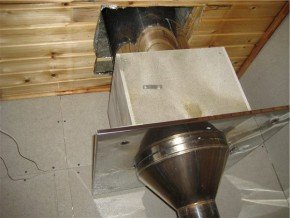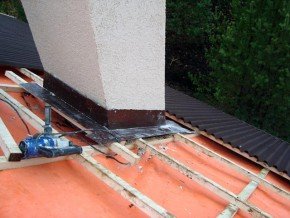Chimney insulation performs two main functions: it protects the building from overheating, possible fires and fires (fire insulation) and prevents moisture from entering the house (waterproofing).
It is recommended to carry out complex insulation of the chimney - this way you will not only solve the main problems, but also improve the working conditions of the furnace. For example, high-quality thermal insulation of a chimney pipe passing through an attic that is not heated prevents overheating of roof elements made of wood, which reduces the risk of condensation that can lead to excessive soot formation, corrosion and destruction of the chimney. Waterproofing will prevent the process of decay of the ceilings and the rafter system. The insulation of the chimney in the presence of certain knowledge in the field of repair and construction can be done by yourself.
DIY fireproof insulation of the chimney

Fire safety prescribes that in places of contact between the chimney and the roof elements made of combustible materials, the temperature should not be higher than 50 degrees.
The perimeter of the hole prepared for the exit of the chimney should be 150 mm. exceed the perimeter of the pipe on each side, when it comes to combustible materials, and by 100 mm. to each side if we talk about non-combustible. If the pipe will go through the finished roofing cake, you should protect the passageway with a box, each side of which should be 150 mm. more relevant sides of the chimney. The resulting distance between the pipe and the duct must be filled with a non-combustible heat-insulating material that is not afraid of moisture.
The insulation films of the roof pie must be cut with an “envelope”, then pulled up to the transverse beam or rafters and securely fixed. The waterproofing, which is already in the roofing cake, should be pressed additionally with a crate to the box, and the vapor barrier should be fixed with frames made of plastic or wooden battens.
To achieve the maximum heat-insulating effect, it is necessary to additionally wrap the joints of the box and insulation films with special non-combustible tapes.
Chimney waterproofing

The chimney can be waterproofed using various materials, however, if you decide to do it yourself, we recommend that you choose roll waterproofing materials for this. The waterproofing process is quite simple, the main thing is to steadily observe the sequence of stages of work:
- Preparatory work consists in cleaning the pipe and roof from dirt and dust and treating the surface with mastic or primer.
- On top of the mastic / primer layer, a diffusion membrane must be glued. It is necessary to glue on the roof surface, wrapping the edges (15-20 cm.) Of the membrane on the pipe so that moisture cannot penetrate under it;
- From the sheet of metal, it is necessary to make the lower and upper "ties", and on top of the crate, fix the bars on which the corners should be fixed with dowels.
- The waterproofing material is spread over with overlapping sheets so that the water flows correctly. Joints are insulated with mastic, cracks are treated with heat-resistant sealants.
- The material from which the roof is made is laid on top of the resulting structure, and then a special plastic apron. Joints are also isolated.
The effectiveness of the complex insulation of the chimney and its longevity depend on how accurately you follow the instructions given above.





Alas, no comments yet. Be the first!